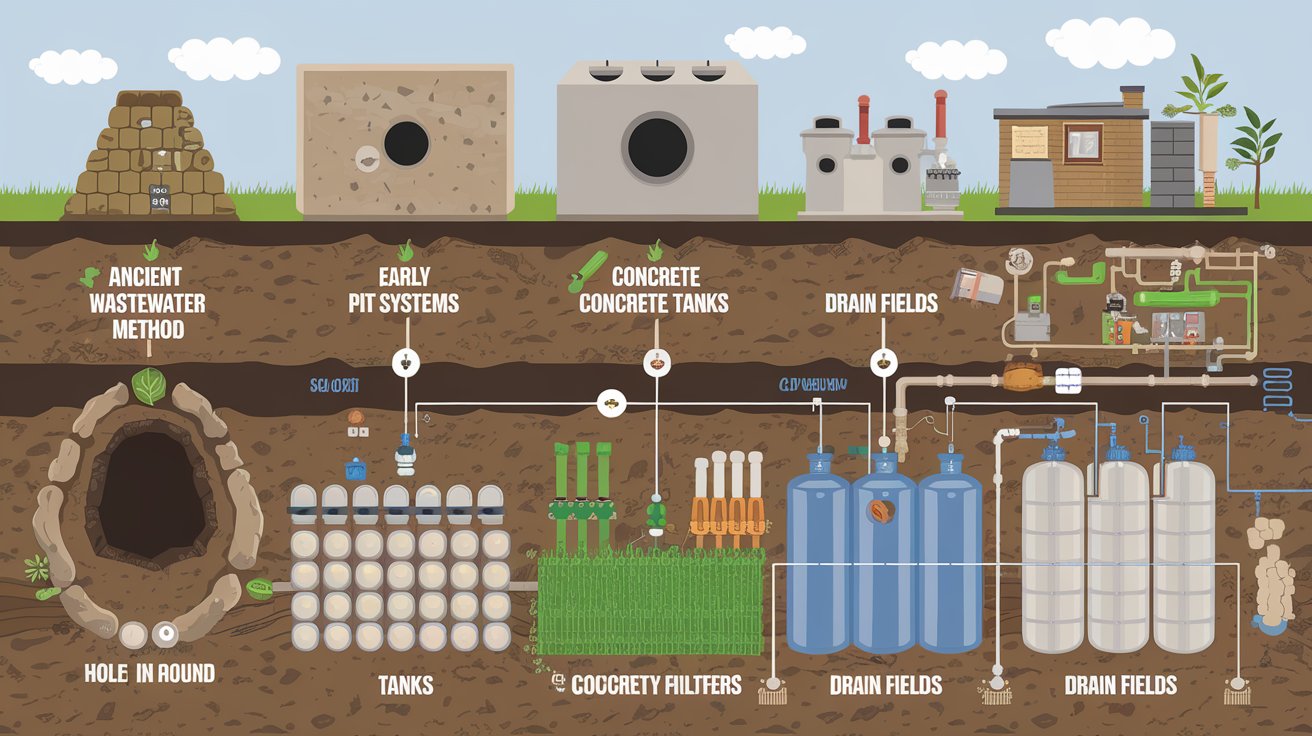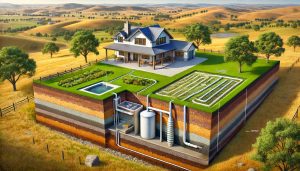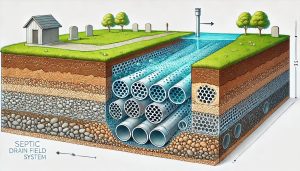Septic systems are crucial for maintaining proper wastewater disposal, especially in rural and suburban areas. Understanding the septic tank history helps homeowners and professionals appreciate the design, functionality, and evolution of these systems. Over time, septic tanks have transformed from rudimentary waste disposal methods into highly efficient and regulated wastewater treatment solutions. This article will explore the evolution of septic systems, from early practices in ancient civilizations to modern eco-friendly technologies. You’ll learn how advancements in materials, environmental regulations, and design improvements shaped the systems we rely on today.
Table of Contents
- Early Wastewater Solutions: Ancient Practices
- The Birth of the Modern Septic Tank
- Technological Advancements in Septic Systems
- Key Components of a Modern Septic Tank
- Septic Permit Links by State
Early Wastewater Solutions: Ancient Practices
Septic Systems in Ancient Civilizations
Before modern septic technologies, early civilizations devised rudimentary wastewater disposal methods to maintain hygiene and public health. While these systems were simple, they laid the foundation for what would eventually become today’s septic tank history. Let’s explore how wastewater management worked in some ancient civilizations.
- Ancient Rome
The Romans were known for their advanced engineering skills, and their wastewater management system reflected this expertise. In ancient Rome, public latrines connected to sewer systems like the Cloaca Maxima played a significant role in sanitation. Waste was directed through elaborate sewer lines, which kept streets and public areas clean. However, these early systems were limited by the technology and materials available at the time. - Indus Valley Civilization
The Indus Valley Civilization, one of the earliest urban centers in the world, also had advanced wastewater management. Archaeological evidence shows that houses had well-planned drainage systems. Wastewater was channeled through pipes made of terracotta, showcasing early forms of sewer systems. These terracotta pipes laid the groundwork for understanding the basic principles of wastewater flow and disposal, which would later influence septic tank history. - Medieval Europe
In medieval Europe, wastewater disposal was more rudimentary but still vital for maintaining public health. Waste was often collected in pits or trenches and left to decompose naturally. Though rudimentary, these early pit systems demonstrated the importance of separating human waste from living spaces, a principle that would evolve into more sophisticated septic tank systems in later centuries.
These early methods of wastewater disposal, while primitive, introduced fundamental concepts of waste management, hygiene, and sanitation. As technology and materials advanced, these ideas were refined into more reliable and efficient septic tank systems. The transition from basic pits and open drains to structured, engineered systems laid the foundation for modern wastewater treatment solutions.
The Birth of the Modern Septic Tank
From Basic Pits to Concrete Systems
By the late 19th and early 20th centuries, wastewater disposal methods began to change dramatically. As populations grew and cities expanded, the need for more effective and sanitary wastewater solutions became evident. This period marked the birth of modern septic tank systems, which incorporated engineered designs and materials to improve functionality and longevity.
- Early Septic Tank Designs
The early septic tanks were simple pits made of wood, stone, or brick. Waste would settle at the bottom, while the effluent (liquid waste) would flow into a nearby drain field. Although these designs were functional, they were often inefficient and prone to failure. Issues like poor filtration, foul odors, and environmental contamination were common. - Introduction of Concrete Tanks
By the early 20th century, concrete began to replace older materials like wood and stone due to its durability and availability. Concrete tanks provided better sealing, preventing leaks and the escape of harmful effluents. These systems were constructed to hold waste more securely, which improved sanitation and reduced environmental contamination. This development was a crucial step in septic tank history, transforming the design from basic pits into reliable household wastewater solutions. - Key Figures and Innovations
Several key figures contributed to the development of modern septic tank systems. For example, John Sanford, an American engineer, is credited with popularizing septic tanks in the early 20th century. Sanford’s design principles emphasized proper waste settling, effluent separation, and efficient disposal through the drain field. His contributions laid the foundation for many of the septic tank regulations and design standards we follow today.
The Shift to Regulations and Health Guidelines
As septic systems became more common, governments and health departments began to recognize the importance of proper wastewater management. Regulations were introduced to ensure the safe and sanitary installation and maintenance of septic systems. These guidelines became critical in maintaining public health and preventing environmental contamination.
- Environmental Concerns and Health Departments
Government agencies, such as the Michigan Health Department, began implementing stringent regulations to protect groundwater quality and overall environmental health. These regulations outlined the standards for tank size, installation, and regular maintenance. Adherence to these septic tank guidelines became a legal requirement for homeowners, ensuring that waste management was both safe and compliant with public health standards. - Environmental Protection Agency (EPA) and National Standards
The Environmental Protection Agency (EPA) in the United States introduced national standards to address wastewater disposal, ensuring that septic systems met environmental guidelines. These standards influenced how modern septic tank designs are constructed, focusing on filtration methods, effluent treatment, and eco-friendly waste disposal practices.
By transitioning from simple pits to engineered concrete systems and adhering to strict health and environmental guidelines, the modern septic tank systems became more effective and reliable. This progress ensured safer wastewater disposal while prioritizing environmental responsibility.
Technological Advancements in Septic Systems
20th-Century Innovations in Septic Tank Design
As technology continued to advance throughout the 20th century, septic tank systems saw significant improvements. New materials, design enhancements, and environmental consciousness contributed to more effective, durable, and eco-friendly wastewater solutions. Let’s explore some of the key technological advancements that shaped modern septic tank history.
1. Materials Revolution: Concrete, Fiberglass, and Plastic
In the early stages of septic tank development, concrete became the dominant material due to its strength and availability. However, as technology improved, other materials began to take precedence in septic tank design.
- Concrete Tanks
Concrete continued to be a popular choice for decades, as it provided durability and resistance to wear and tear. Concrete tanks became a staple in households because of their cost-effectiveness and longevity. - Fiberglass Tanks
During the mid-20th century, fiberglass became a viable option for septic tanks. Fiberglass tanks are lighter than concrete, resistant to corrosion, and less prone to cracking. This material made installation easier and provided an excellent long-term solution for wastewater management. - Plastic (Polyethylene) Tanks
In more recent years, plastic or polyethylene tanks have gained popularity due to their affordability and resistance to rust and corrosion. These tanks are lightweight, easy to transport, and quick to install. They are also less susceptible to groundwater contamination, making them a preferred choice in many modern installations.
2. Improved Filtration and Drain Field Technologies
As septic tank history progressed, it became clear that effective wastewater filtration was crucial to environmental safety and public health. Advances in drain field and filtration technologies helped ensure that treated effluent was clean and safe before dispersing back into the environment.
- Effluent Filters
Modern septic systems now include effluent filters, which prevent solids from escaping the tank and clogging the drain field. These filters ensure that only liquid waste is filtered through, significantly prolonging the life of the system and protecting the surrounding soil. - Advanced Drain Field Designs
Drain fields also saw improvements in their design, incorporating technologies that maximize the distribution of wastewater across the soil surface. Better distribution methods help prevent localized contamination and promote natural filtration, which is crucial for maintaining soil health and preventing harmful pollutants from leaching into water sources.
3. Aerobic Septic Systems
While traditional septic systems rely on anaerobic digestion (breaking down waste without oxygen), aerobic septic systems became a noteworthy innovation in the 20th century.
- How Aerobic Systems Work
Aerobic septic systems introduce oxygen into the wastewater treatment process, allowing microbes to break down waste more efficiently. This method results in cleaner effluent and is particularly useful in areas where groundwater contamination is a major concern. - Environmental Benefits
Aerobic systems are often seen as a more environmentally responsible choice. They reduce the risk of harmful contaminants reaching water sources and soil, aligning with modern environmental guidelines for wastewater management.
4. Monitoring and Automation Technology
Technological advancements also introduced monitoring and automation features into septic system design, enhancing reliability and efficiency.
- IoT and Sensor Integration
Modern septic systems often include IoT sensors and smart technology to monitor tank levels, detect leaks, and measure effluent quality. Homeowners and professionals can access real-time data, ensuring proactive maintenance and avoiding costly repairs. - Automated Pumps and Valves
Automated pumps and valves are now integrated into many septic systems. These components regulate wastewater flow, optimize effluent distribution, and prevent system overloads. This automation minimizes the risk of system failures and extends the lifespan of the entire septic system.
5. Eco-Friendly Septic Solutions
As environmental awareness grew in the latter part of the 20th century, eco-friendly septic technologies became more prominent. Innovations were aimed at reducing environmental impact, ensuring compliance with septic tank regulations, and protecting natural resources.
- Eco-Conscious Materials
Manufacturers began using sustainable materials, like recycled plastics and eco-friendly concrete, in septic tank construction. These materials are less harmful to the environment and offer durability and functionality without compromising sustainability. - Natural Wastewater Treatment Solutions
Green technologies, such as constructed wetlands and biofilters, were developed to provide natural wastewater treatment. These solutions use plants, rocks, and soil to treat effluent, creating a more sustainable and environmentally friendly wastewater management system. - Regulatory Compliance and Environmental Guidelines
Agencies such as the Michigan Health Department and the EPA introduced guidelines ensuring eco-friendly installations and maintenance practices. These regulations emphasized waste treatment efficiency, groundwater protection, and proper drain field construction, ensuring long-term environmental safety.
6. Maintenance Innovations
Septic tank maintenance has also evolved significantly. Maintaining a healthy septic system is critical to its longevity, functionality, and environmental protection.
- Advanced Maintenance Tools
Professionals now use advanced tools and diagnostic equipment to monitor septic system performance. Septic camera inspections, for instance, allow technicians to identify blockages and leaks without extensive digging or disruption. - Maintenance Schedules and Guidelines
Regulatory guidelines and professional services now recommend regular maintenance schedules, which include pumping, effluent testing, and drain field assessments. Adhering to these schedules prevents costly repairs and ensures compliance with septic tank regulations set by local health departments and environmental agencies.
These technological advancements illustrate how the modern septic tank history has been shaped by innovation, environmental responsibility, and the necessity of compliance with health and environmental regulations. The transition from basic pits to sophisticated, automated, and eco-friendly systems reflects the commitment to creating wastewater management solutions that are both effective and sustainable.
Key Components of a Modern Septic Tank
Understanding the key components of a modern septic tank system helps homeowners and professionals appreciate the complexity and functionality of wastewater treatment. Each part plays a crucial role in ensuring that waste is properly managed and that the system complies with environmental and health guidelines. Let’s explore the main components of a modern septic system and their functions.
1. The Septic Tank
The septic tank is the central component of any septic system. It serves as the primary point of wastewater treatment, separating solids, liquids, and scum to prevent contamination and protect the environment.
- Functionality
- Waste enters the septic tank from household drains (toilets, sinks, showers, etc.).
- Inside the tank, solids settle at the bottom, creating a layer of sludge.
- Oils and fats float to the top, forming a scum layer.
- The liquid effluent flows out of the tank into the drain field for further treatment.
- Material Composition
- Concrete Tanks: Known for durability and longevity. Often made from reinforced concrete to prevent cracking.
- Fiberglass Tanks: Lightweight, corrosion-resistant, and easy to install.
- Plastic Tanks: Affordable and eco-friendly, resistant to rust and corrosion.
Understanding the tank’s construction and functionality helps homeowners maintain it properly and follow septic tank maintenance guidelines.
2. The Drain Field
The drain field, also known as the absorption field, is a crucial component where the effluent is filtered and safely dispersed into the soil.
- Purpose
- Distributes effluent evenly across the soil surface.
- Allows natural filtration to remove contaminants, ensuring clean effluent is absorbed back into the environment.
- Drain Field Components
- Gravel Beds: Provide effective drainage and support proper wastewater distribution.
- Pipes: Distribute effluent evenly across the drain field.
- Soil Layers: Act as a natural filtration system, breaking down waste particles and purifying effluent before it re-enters the groundwater.
Properly functioning drain fields are essential in maintaining compliance with septic system regulations, such as those outlined by the Michigan Health Department guidelines.
3. Inlet and Outlet Pipes
The inlet and outlet pipes are vital components that regulate the flow of wastewater into and out of the septic tank and drain field.
- Inlet Pipe
- Carries wastewater from household drains (toilets, sinks, showers) to the septic tank.
- Often made from durable materials like PVC to prevent leaks and cracking.
- Proper inlet design ensures that wastewater flows smoothly and without blockages.
- Outlet Pipe
- Transfers liquid effluent from the septic tank to the drain field.
- Often connected to an effluent filter, which prevents solids from escaping the tank.
By maintaining these pipes according to septic tank history and current standards, homeowners can prevent system backups and reduce the risk of costly repairs.
4. Effluent Filter
The effluent filter is a protective component installed in the outlet pipe of a septic tank to prevent solids from escaping into the drain field.
- Purpose
- Ensures that only liquid waste is transferred to the drain field.
- Prevents clogs and damage to the drain field by filtering out solid particles.
- Maintenance
- Requires regular cleaning and replacement to maintain system efficiency.
- Often positioned inside the septic tank outlet pipe, making it easily accessible for professional cleaning and maintenance services.
Effluent filters are essential in adhering to septic system regulations and environmental guidelines, safeguarding the integrity of the drain field and local ecosystems.
5. Inspection Ports
Modern septic systems include inspection ports, which provide access to various sections of the system for maintenance and diagnostics.
- Purpose
- Allows professionals to perform routine inspections, cleanings, and maintenance tasks.
- Enables septic technicians to assess sludge and scum levels, test effluent quality, and identify potential issues early on.
- Placement
- Often located above the septic tank, drain field, and key inlet and outlet areas.
- Made of durable materials like concrete or heavy-duty plastic.
Inspection ports are critical tools for maintaining a functioning septic system and ensuring compliance with health department guidelines and septic tank regulations.
6. Vent Pipes
Vent pipes are an often-overlooked but essential component of a modern septic system. They allow gases to escape safely and help maintain system pressure.
- Purpose
- Prevents the buildup of harmful gases, such as methane and hydrogen sulfide.
- Ensures proper airflow throughout the system, which helps maintain efficient waste breakdown and prevents odor buildup.
- Material and Placement
- Typically made from materials like PVC or cast iron.
- Positioned on the top of the septic tank or connected to inlet and outlet pipes.
By incorporating vent pipes into the design, septic systems prevent harmful gas accumulation, ensuring safety and functionality in line with septic system regulations.
7. Pump System (Optional Component)
Not all septic systems require a pump, but many modern designs include one, especially in areas with difficult terrain or non-standard layouts.
- Purpose of the Pump System
- Transfers effluent from the septic tank to the drain field when gravity flow is not feasible.
- Commonly found in septic systems with elevated drain fields or remote locations.
- Types of Pumps
- Effluent Pump: Used to transfer treated effluent from the tank to the drain field.
- Lift Station Pump: Installed in areas where wastewater must be elevated before disposal.
Pump systems play a significant role in ensuring that septic systems remain compliant with local health and environmental regulations, like those set by the Michigan Health Department.
Conclusion
Understanding the key components of a modern septic system reveals how wastewater is effectively managed, filtered, and dispersed while ensuring compliance with septic tank history, environmental guidelines, and health regulations. Components such as the septic tank, drain field, inlet and outlet pipes, effluent filters, inspection ports, vent pipes, and pumps each play a vital role in maintaining system functionality and longevity.
Regular maintenance and adherence to septic system regulations are crucial in preserving the environment and public health.
Directory | Washington Septic Service Providers | Part 2
Directory | Washington Septic Service Providers | Part 1
DIY Repairs Are Always Cheaper
Septic Regulations in Rural Areas: Essential Guide for Rural Property Owners
The Role of Perforated Pipes in Drain Fields
What Happens During a Pumping Service?
Septic Tanks vs. Sewer Systems | Choosing the Right Option
Directory | Virginia Septic Service Providers | Part 2









